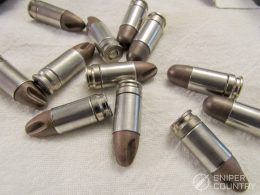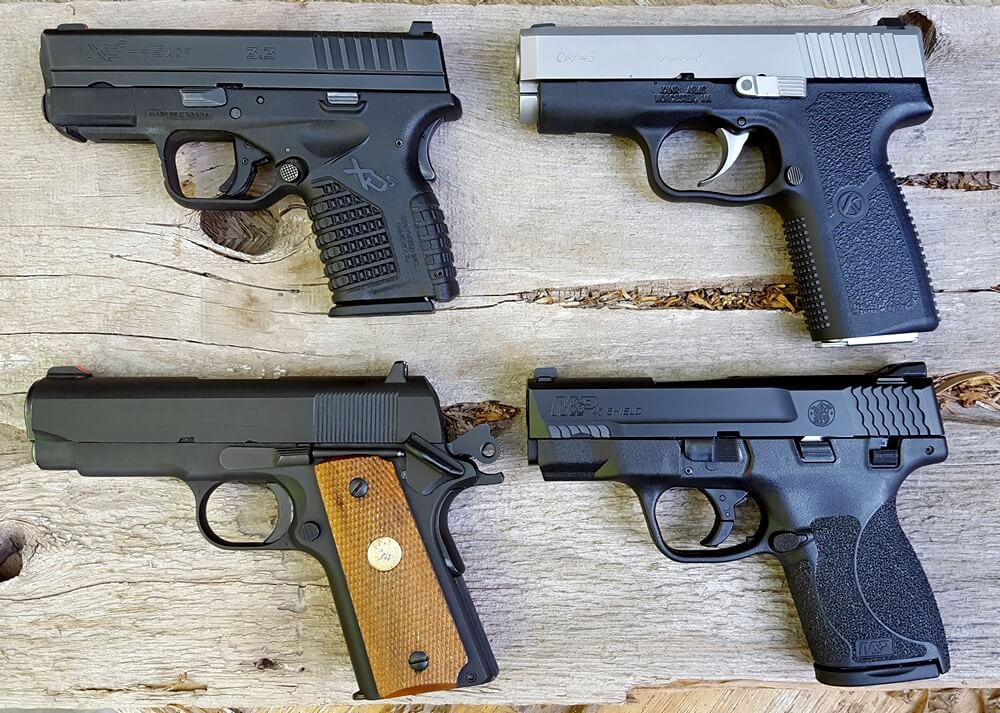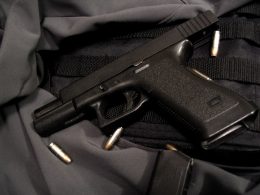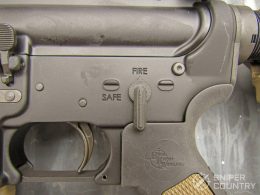In this Article:
This article/review is about Taurus’ relatively new .380 ACP handgun, the Spectrum. But, before we get into discussing the Spectrum itself, a word about Taurus may be in order. (To cut to the chase, I really like my Spectrum – it’s a very reliable pistol). The following is directed at those who are not fans of Taurus guns…I feel I need to address this before I review the Spectrum as one has a direct impact on the other.
Taurus has, over the years, introduced guns that have captured the attention of the shooting public, for better or worse. To be honest, if you mention Taurus guns to some shooters you will get back a comment similar to “oh, Taurus, huh… those are lousy guns!†In a similar vein, read through many online gun forums and you will read similar statements. What is important to note about these comments, however, is that the speaker may or may not have ever actually held a Taurus gun, let alone have shot one. They are experts on these guns from what they have heard or read, usually from someone who also may not have had direct experiences with them.
Am I saying that Taurus always hits home runs with their products? Of course not – I’ve had to send guns back for repair so I have experienced what was their less-than-stellar customer service firsthand years back. The point I am trying to make is that Taurus is under new leadership and they are trying hard to dispel those negative reactions. Used to be, several years ago, that Taurus quality control was not that great. Guns would be shipped that still needed work in order to be ready for sale. That’s not the case anymore, for the most part. Let’s look at a quick history of the company, and then get into the Spectrum.
Taurus History
Taurus was founded in 1939 as a tool and die manufacturing plant. It is located in Brazil, in São Leopoldo, Rio Grande Do Sul. Today, it not only makes firearms but also has separate divisions that make other products: metals manufacturing, body armor, plastics and helmets. The company is also big in civil construction. In 1941, the company produced its first firearm – a .38 Special. The model number of that first gun was 38101SO. Here it is:
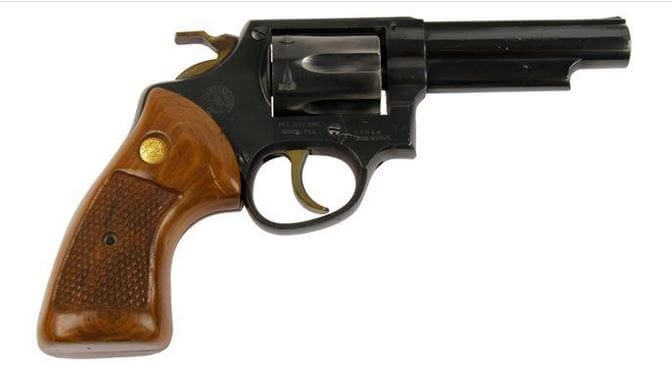
Smith and Wesson Enters The Picture
In 1968, Taurus started exporting guns to the U.S. through various importers. We now will answer some questions that have been asked for years about some Taurus revolvers – why do they look like Smith and Wessons? Can’t S&W sue them? The answer to those questions concerns parent company ownership. In 1970, Smith and Wesson’s parent company, Bangor Punta, purchased 54% of Forjas (Forge) Taurus. This allowed the sharing of designs, machines, ideas and other aspects of firearms manufacture. This arrangement continued until 1977, when the current owners bought Taurus and severed the S&W relationship. That is why Taurus revolvers tend to look like Smith and Wessons. It is important to point out that the flow of ideas was not only one-way. Taurus helped Smith and Wesson, with their engineering practices and designs as well as the other way around.
As an example, here is an example of a current-production Taurus revolver, a Model 44 in .44 Magnum…
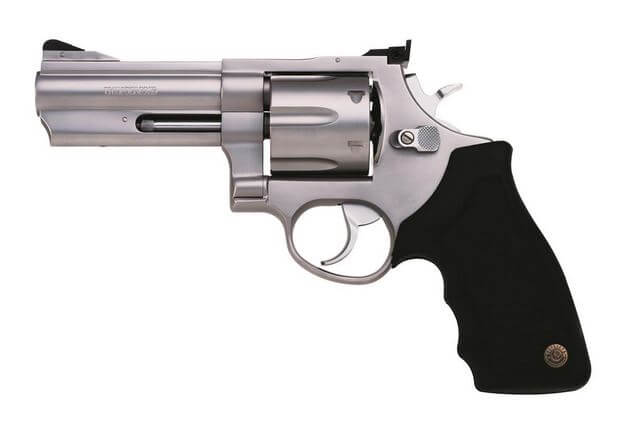
… and a current-production S&W Model 629, again a .44 Magnum revolver:
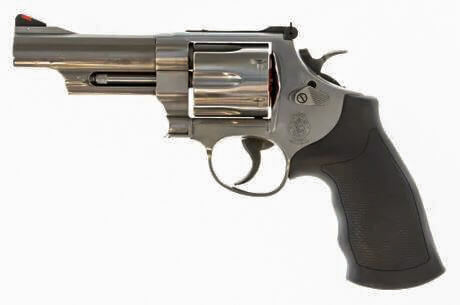
So, we see that the Taurus Model 44 looks an awful lot like the S&W 629. The only reason I mention this is to help us to remember that Taurus, at one time, was affiliated with one of the largest quality revolver makers in the world and no doubt benefitted from that connection, as did Smith and Wesson.
Beretta, Too?
In 1980, after Beretta had fulfilled its contracts to produce firearms for the Brazilian military, Taurus bought the Beretta plant in Sao Paulo, along with tooling, production licenses and designs. They even hired the workforce that was producing the guns.
Here is an example of how that business transaction benefitted Taurus:
Beretta Model 92FS…
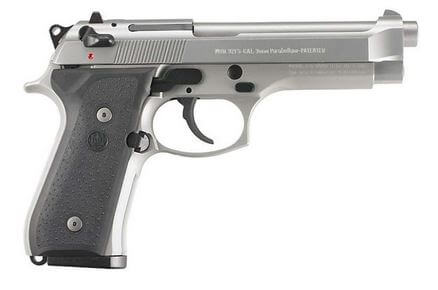
…and the Taurus PT-92 FS, one of the most reliable, best-selling Taurus guns out there:
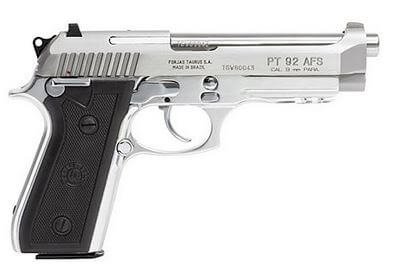
OK. We see how Taurus has built guns similar to those of other manufacturers after acquiring the rights to do so. Some even say they improve the designs…I’ve read positive comments about how Taurus moved the safety from the slide to the frame on the PT92 above, as one example. Whether or not you agree, the fact is that Taurus is one of the largest handgun manufacturers in the world today and has had help from some fairly high-placed manufacturers along the way.
Taurus USA
In 1984, Taurus created a subsidiary company: Taurus USA. The purpose of this was to concentrate on the American market and ease importation of guns to the U.S. (It has grown to the point where several Taurus guns are now manufactured in the U.S., including the Spectrum). Rossi Firearms was acquired by Taurus in 1997, which allowed Taurus to expand into the long gun market in earnest. I owned a Rossi lever action Model R92 in .45 Colt – it was quite a nice gun, considering its cost, and accounted for a couple of deer. Another interesting point – Taurus has evidently phased out the production of Rossi handguns, according to the Rossi website. Rossi makes only long guns now. One of the most accurate .357 revolvers I’ve ever owned is a Rossi 6-incher. That thing shoots like nobody’s business. One of our sons liked mine so much he bought one of his own. Sadly, they are no longer made.
Taurus guns tend to cost less to buy than some other brands. Some possible reasons for that might be that the cost of the labor force in Brazil doesn’t take away as much from the bottom line as do the work forces at some firearms manufacturers in other parts of the world. Costs are held down because of that. The other reason is that Taurus make just about every part that goes into their guns. Not being at the mercy of suppliers has its merits in terms of cost-saving.
OK…we’ve had our history lesson. Now, where does the Spectrum fit in?
Taurus has long been known as a manufacturer of small, concealable pistols. Their foray into the .380 market was undoubtedly guided by the fact that the .380 has grown to be one of the most popular self-defense cartridges out there. Innovative bullet design and ballistics have pushed the little .380 into the forefront of concealed carry calibers. Even as few as 10 years ago, there just wasn’t much in the way of effective self-defense ammo available for the .380, but that has changed. (Here is my article on the top-notch .380 carry ammo). Some experts even equate the effectiveness of the best .380 carry ammo to be almost equal to that of the venerable .38 Special. However you feel about this topic, the fact is that the growth of the .380 pistol and ammo markets has shot through the roof in recent years. Taurus has had a few players in that game.
BONUS OFFER: Get your free shooting range targets to print at home!
Get your free targets to print at home!
The Spectrum’s Lineage
A couple of Taurus .380 pistols that helped lead the way for the Spectrum’s inception were the TCP(380) and the Curve, neither of which are shown on Taurus’ website now – the Spectrum is the only .380 in current production.
The TCP was a small, pocketable gun that held 6+1 rounds and weighed a hair over 10 ounces.
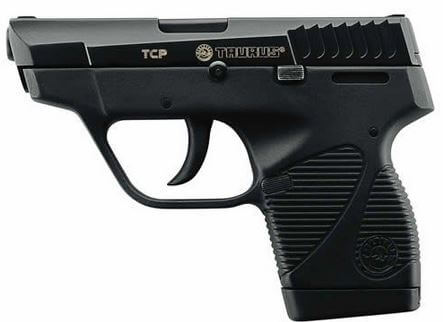
Taurus called it a double-action-only (DAO) gun, but the slide did need to be manipulated in order for it to fire again. Sights were rudimentary (as are almost all pocket 380 sights), but it was a popular gun. It was roughly the same size as a Kel Tec P3AT or a Ruger LCP. The gun was popular, which led Taurus to bring out something else, about five years ago…
The Curve

The Curve was Taurus’ attempt to create a carry gun complete with everything you need built-in or included.
I think Taurus might have had these outcomes in mind when they designed this gun:
- it came with a belt clip, so no holster was needed.
- even so, a trigger guard “holster†of sorts came with it that covered the trigger guard and had a lanyard so that when you drew the gun, the cover pulled free.
- it had two LED white lights and a red laser (at extra cost. The base model didn’t have these). The laser and lights were activated by the switch in front of the trigger guard in the photo. Right-side only.
- it came with two magazines. There was no magazine release on the frame-you squeezed the big bottom on the left bottom of the magazine to release it. Again, a right-handed-only feature.
- The reason it is called the “Curve†is that it is, well, curved. The gun, when viewed from the rear, has a pronounced “bend†going from 12:00 to 6:00, outward at 3:00. This makes it fit the human body better, if you’re right-handed, that is – Taurus didn’t really elaborate on the fact that the gun immediately alienated the 10% of us shooters who are left-handed.
- no raised or protruding sights…there is a cross-hair of sorts at the rear of the slide that’s supposed to help you line the gun up for the shot. Maybe, after the designers announced this “feature†is when the built-in laser was added.
- it was a DAO gun, but like the TCP380 you had to rack the slide in order to have it re-strike.
These guns came before the Spectrum. The Spectrum was supposed to be released in January of 2017, but delay after delay didn’t allow it to actually hit dealers’ shelves until almost a year later. I remember reading about it and thinking that the gun should be a decent carry gun, if all the hype was true. It was the first “designer†.380 I’d seen, coming in all those colors, but for the longest time (until fairly recently), you could only buy the black-on-black and gray-on-black models-more on the colors in a bit. Another main difference with the Spectrum and other pistols is that there are no slide serrations – the grip panels and slide gripping area are covered with a soft-touch rubber material that really, truly does allow a good grip when you rack the slide and comes in different colors. So, just how big is this little gun?
Spectrum Specifications
Let’s look at the guns’ specs and see some photos of it and its various components.
| Length: | 5.4 in. |
| Height: | 3.8 in. |
| Width: | 0.89 in. |
| Weight: | 10 oz. (unloaded, approx. 13 ounces loaded) |
| Capacity: | 6 round flush mag; 7 round extended mag. |
| Barrel: | 2.8 in. |
| Action: | True DAO – no pre-loading or pre-cocking of the striker. Double-strike capability |
| Sights: | Integrated (non-adjustable) rear notch and front post |
| Trigger pull: | 7-9 lbs. |
| Mag. Release: | reversible |
| Slide Stop: | last-shot hold-open |
| MSRP: | $289 (house colors); $305 (custom colors). |
| Real-World Pricing: | I have seen the Spectrum advertised on sale for as low as $130 |
Popular Articles
Photos
I took my Spectrum apart for its photoshoot – here we go…
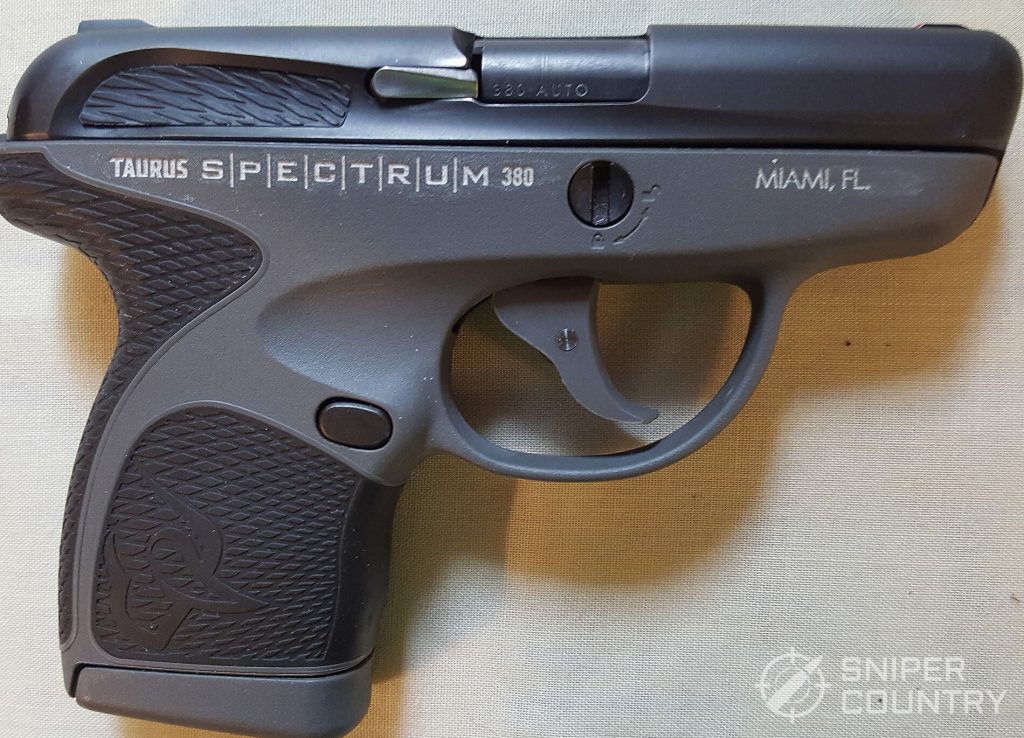
(the white letters are my doing, obviously – I’m still working on them. I like a little contrast on my gun frames)

2.8-inch barrel. Unlike the Taurus Curve when it first came out, it actually says “380 Auto†on the barrel. The first Curves had no caliber designation on either side, a matter that was soon remedied.
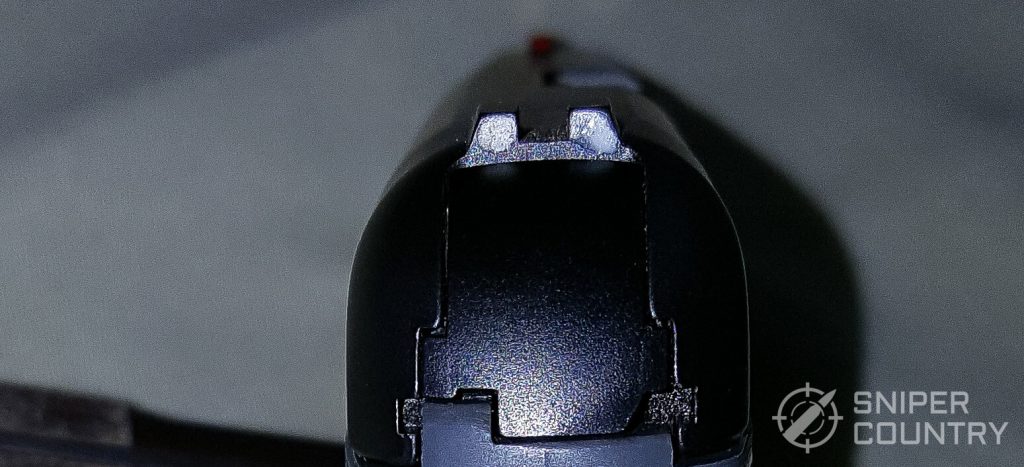
Rear sight with two white “dots†added by me. The flash sort of melts them a bit. At least there is a rear sight, unlike on the Curve.
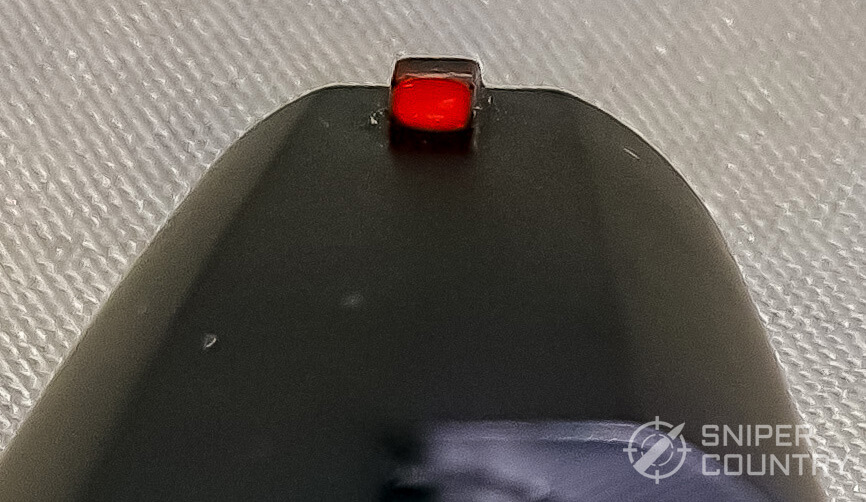
Front sight. More of a bump than a ramp or post. With a dab of bright nail polish it works. This sight, like the rear sight, is milled into the slide and is not adjustable with anything short of an angle grinder.
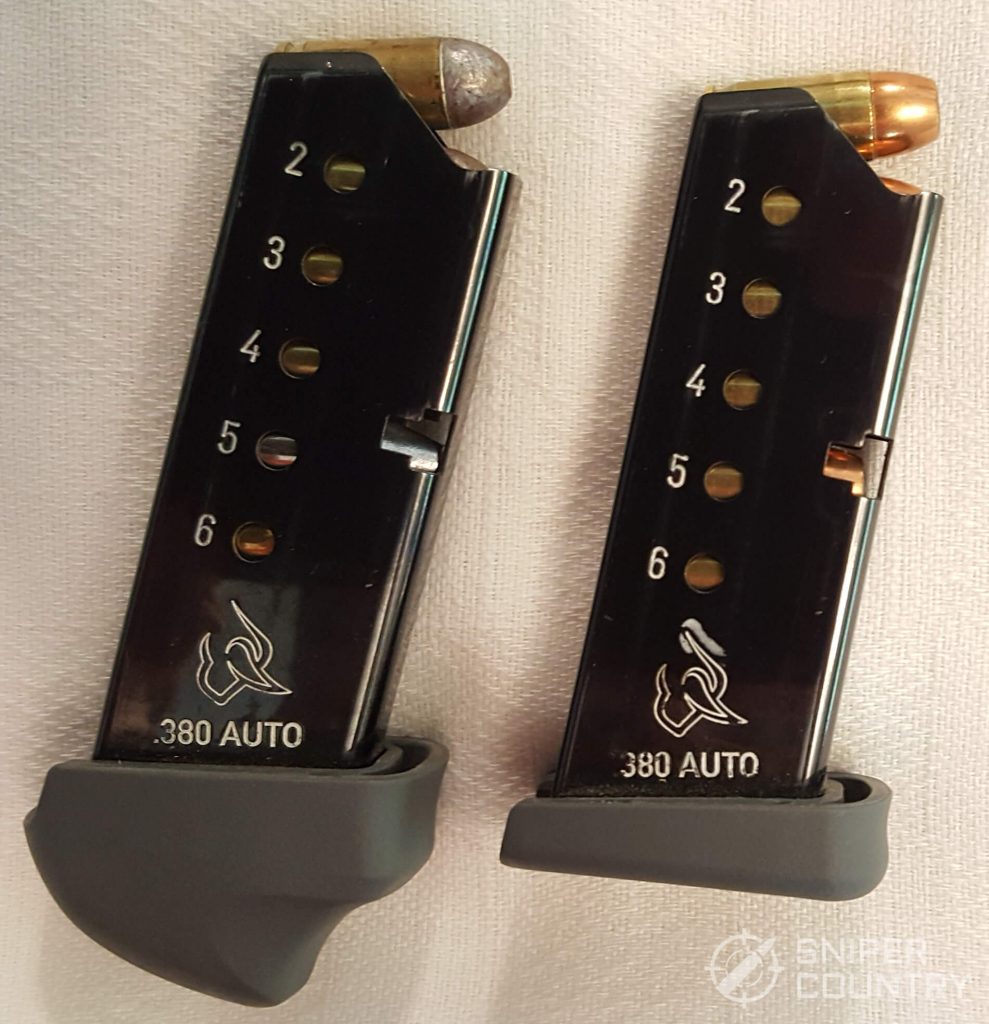
Six- and seven-shot mags. I painted the numbers so as to make them more visible to my aging eyes, and I painted the logo just because I wanted to. Notice the finger extension on the 7-rounder. I can get all three fingers on the gun with that mag in it. Interesting note – on the reverse side of the mags, at the bottom, is scribed “Made in Italy†(below). This suggests that these are very possibly Mec-Gar mags, some of the best going. I couldn’t verify that, but I’d bet that’s where they come from.
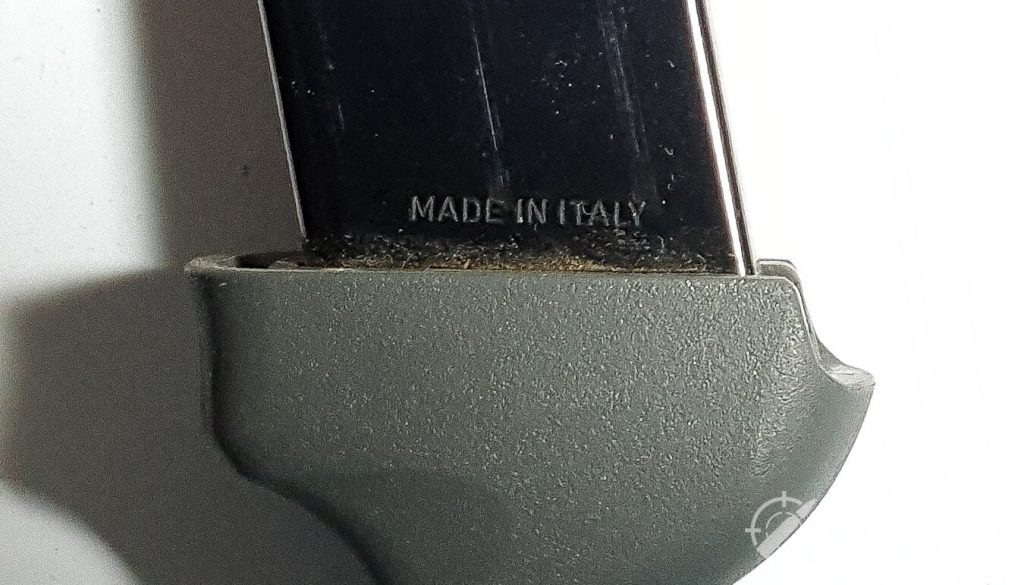

Inside the slide. Nothing revolutionary here.
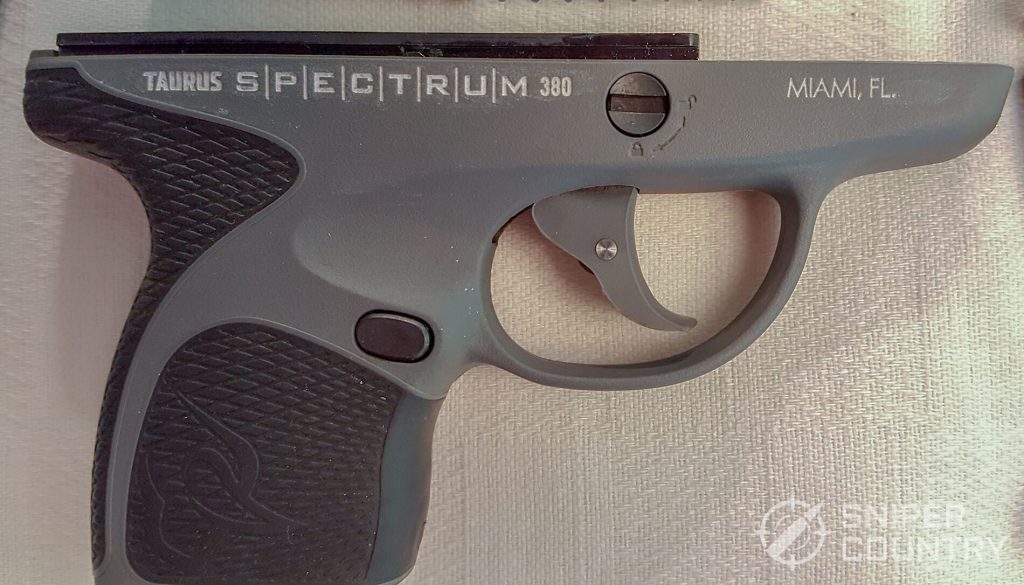
Right side of frame…note full-length rail and takedown lever access slot. The trigger is well-built and rather large for good finger purchase, but only has about an 8-pound pull weight. It is a bit gritty, but continuous shooting has helped in that area by smoothing things out. One more point – as mentioned above, the magazine release is reversible for lefties like me.
Taurus Colors
When first introduced, Taurus placed this graphic on the taurusspectrum.com page…on that site, you can “mouse over†the different colors and then view that gun on the left in those colors.
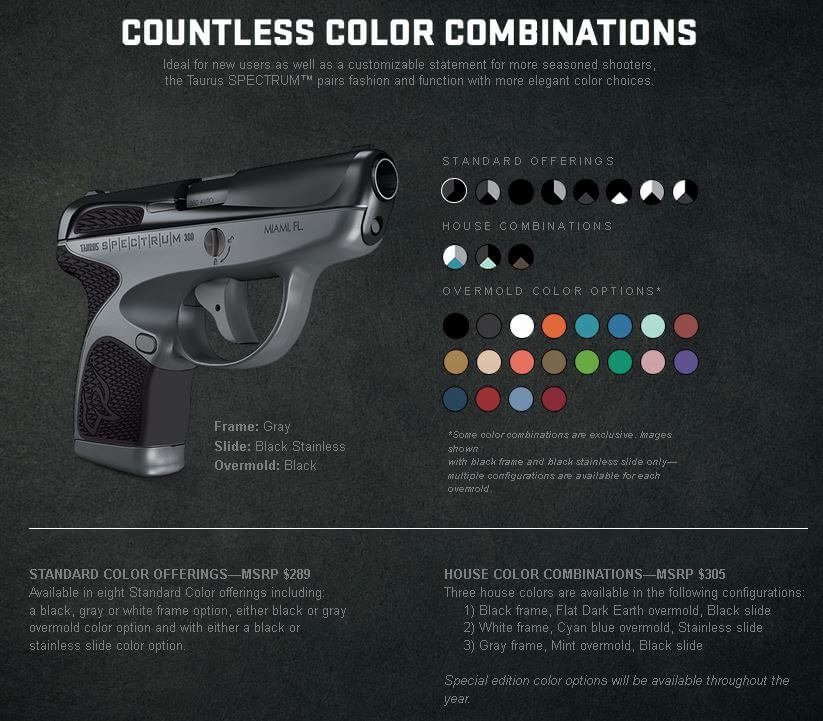
It was obvious from day one that Taurus was not only marketing the gun to traditional male shooters (blacks and grays), but also to females as well. The colors were available for three different parts of the pistol – the frame, the slide and the “overmold†(rubberized gripping areas). As you can see, if you wanted one in standard house colors, the MSRP was $289. But, the “House Colors†cost more. One of the most popular combinations is the first â€house combination†with the gray frame, white slide and teal overmolding. An interesting story comes to mind about that combination. I have a very good friend, a guy I grew up with, who is into guns and whose dad was a military arms collector. He is very selective about his guns and knows what he wants. I had obtained my black/gray Spectrum when he was here for a visit (he lives in another state). He shot it and liked it. He just didn’t like my guns’ colors. So, he ended up waiting until that house combination became available and bought that. That just proved to me that we can’t really assign possible gun colors to specific genders…I would never had thought that he would be a teal kind of guy, but I would’ve been wrong. He loves his Spectrum, by the way. And he’s a good shot, so I don’t tease him about his color choice…
So, no matter what colors you want, they are available…finally. As I said above, it took Taurus many months to get geared up for production, and then at that time only certain colors were available. It was the “talk of the forums†– the fact that Taurus had introduced a pistol it couldn’t deliver to dealers’ shelves for months. I think some were calling it the “ghost gun.†They do at least offer a disclaimer of sorts…read the last line in the photo above: “Special edition color options will be available throughout the year.†If you wanted, say, a black frame, black stainless slide and monster green overmolds (a real option, looks more like lime to me), it took a while longer. Mine was one of the first available – it is the very first option shown on the color chart. I would’ve liked a stainless slide, but it was either take the one Duane had or wait…and wait…and wait. And, when it’s all said and done, the darker colors fit my idea of a concealed carry gun more so than, say, one with Laguna Blue or Orange ovemolds. As always, your choice may be different than mine – different strokes. The point is that, no matter which color combo you choose, they’re all variations of the same gun and that gun will shoot. Speaking of shooting the Spectrum, let’s look at that now.
BONUS OFFER: Get your free shooting range targets to print at home!
Get your free targets to print at home!
Shooting The Spectrum
When I first picked up the Spectrum, it didn’t feel much different than other small .380s I’ve handled, such as the Ruger LCP, Kel Tec P3AT and similarly-sized guns. But, there was a fairly big difference between the Spectrum and all the other pocket .380s. That was the fact that the Spectrum has had literally every edge “melted†to make it totally snag-proof on the draw. There are no sharp corners or edges. Somebody in the design department either really did their homework and surveyed concealed carriers, or is a concealed carrier him- or herself. That’s why the sights are as they are…useable but not obtrusive. I mention the frame melt and rounded edges here instead of in the carry section of this piece because if it has been TOO rounded, it could be slick and not able to be grasped in a shooting grip easily. So, how does this rounded-edge marvel shoot?
In a word, good. I have had mine for about a year and have had a chance to shoot it with several different types of ammunition, including handloads. (Yep, I’m one of those who actually pick up fired .380 cases and stuff ‘em with powder and bullets…it’s cheaper than factory loads!).
Shooting Impressions
Before we look at actual targets, I want to go over what I first experienced when I first shot the little guy. When I picked it up, it fit my hand…especially with the extended 7-round magazine. There’s nothing wrong with the flush-fit 6-rounder – with that one in place, it’s the same old story of two fingers on the grip and the pinky finger curled underneath. This is truly typical for many guns of this type, so it’s no big deal. The gun is very controllable with this mag in place – it’s just more so with the extended one. The design team must have printed the word “ERGONOMICS†in huge letters and taped that everywhere in their offices, as the Spectrum is one of the most ergonomically-pleasing small pistols I’ve shot. A side note: we hear that word flung about in gun reviews, but what does it actually mean and how does that apply to the Spectrum? The definition of ergonomics, according to Merriam-Webster is in two parts:
- an applied science concerned with designing and arranging things people use so that the people and things interact most efficiently and safely — called also biotechnology, human engineering, human factors
- the design characteristics of an object resulting especially from the application of the science of ergonomics
So, with the “official†definition of ergonomics before us both as a noun and an adjective, how does it apply to the Spectrum? One of the most visible ways that the “E†word was integrated into the design is by the lack of slide serrations. On a gun of this size, serrations with which to grip and retract the slide are notoriously small – witness the Beretta Pico. Those slide serrations are tiny. So, it made sense to put some sort of “grabby†material on the slip and grip frame that would allow the shooter to get a firm grasp on the gun. The rubberized material works. It’s soft enough to allow a good grip but at the same time it doesn’t “give†too much. Here’s a close-up of it, on the grip frame and slide:
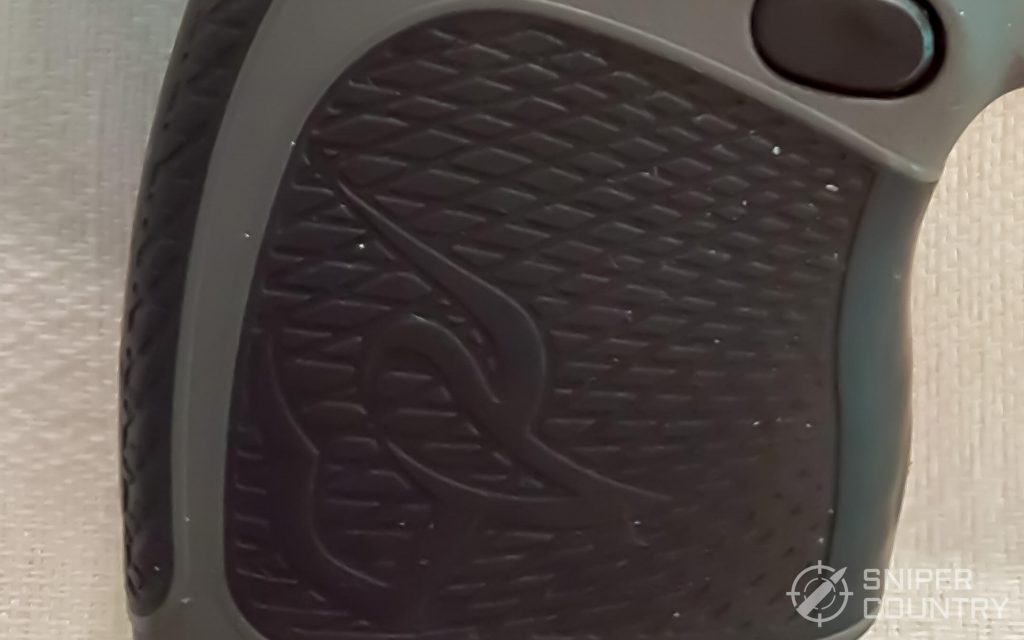

What gives you a little extra grabbing power on the slide are the little “wings†built into the rear of the slide. If you look at the photo, you’ll see a ridge of sorts at the rear of the grasping area. This, along with the grippy rubber texture, helps you get a firm grasp on the slide in order to retract it.
What this means in terms of shooting the little gun is that it tends to stay put in your hand, I don’t know how many guns I’ve shot over the years that required a new grip after every shot because of its “wiggle factor.†This gun doesn’t do that.
In another nod to the “E†word mentioned above, Taurus has made the gun easy to get both hands on. Now, I have average-sized hands and I would imagine that if you wear XXXL gloves this might not be the case, but for me, my support hand just naturally lies alongside the frame with a thumbs-forward grip. My support thumb just naturally falls on the takedown lever’s slot (I’m left-handed), so I can index it there every time. The design gang at Taurus got the ergonomics right with the Spectrum.
How Does It Shoot?
Let’s look at how the Spectrum shoots. Depending upon ammunition, it is very controllable, as I mentioned above. Self-defense ammo causes it to recoil a bit more (not unusual) but I can’t call it “snappy  it just kicks a little more. Granted, the 380 is not going to be in the same recoil class as, say, the .40 S&W but you have to remember you’re shooting it out of a 10-ounce gun. The gun just bucks a bit, but is by no means hard to control. I think Taurus might have anticipated that the gun would be a decent, easy shooter for both males and females so they make it in colors that both genders of shooters might like.
Accuracy
Let’s look at a few targets I shot, with four types of ammunition. Factory loads included two JHP and one FMJ loads. I also shot one handload. I shot a five-shot group of each at a measured 7 yards from a rest. The velocities are the average of a five-shot average over my Caldwell chronograph at 10 feet from the muzzle to chronograph.
American Gunner 90-grain XTP 857 f.p.s.
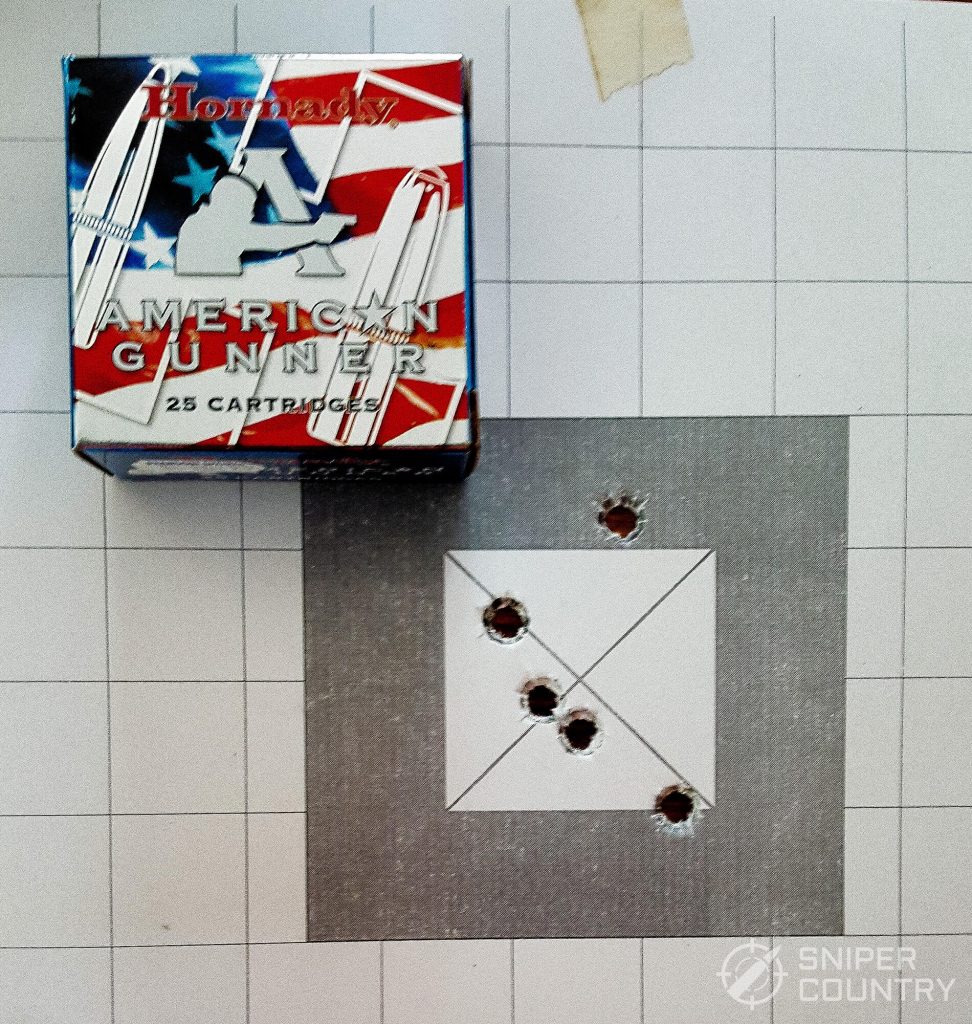
This load was, along with the other FMJ Aguila load, among the harder-kickers of those I shot. I was a bit surprised at the relatively low velocities recorded by the three factory loads – my handload is tailored to be a practice load so I wasn’t too worried about its velocity. I was just expecting more out of the defense rounds.
Aguila Factory 90-grain JHP 873 f.p.s.
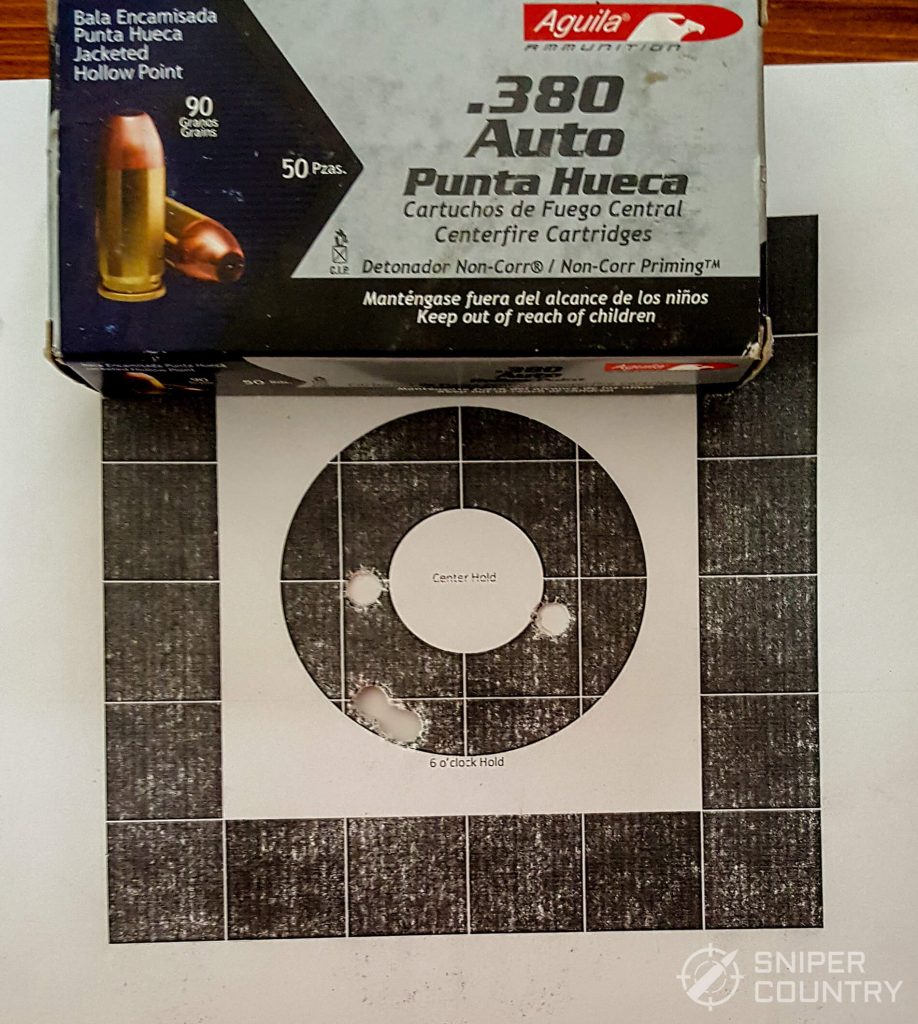
There are five shots on this target, truly. Not too bad.
Monarch 94-grain FMJ 859 f.p.s.
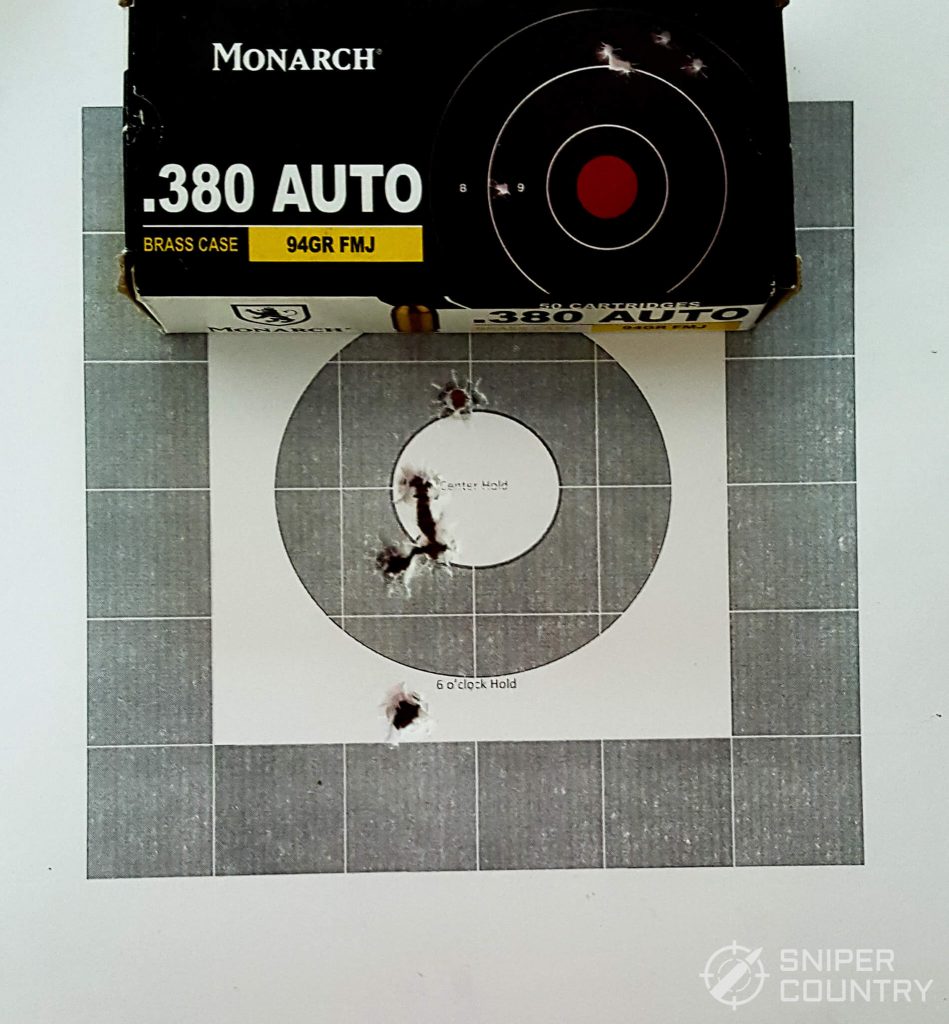
The Monarch brass-cased ammo was the only one of the four that had ejection issues. Using the extended magazine, I had a FTE twice. A stovepipe was the result the first time and the second malfunction was caused by the case just not making it out of the ejection port horizontally. I’m not sure if it was due to my grip (small guns sometimes require a gorilla grip in order to function properly) or the ammo. At any rate, it would make decent practice or range ammo, plus it may work just fine for you. Every gun is different. The brass-cased Monarch is made by PPU in Serbia, while their steel-cased ammo is made in Russia. Monarch has just about become Academy Sport’s house brand, if there is such a thing. And…the cases are reloadable, which is important to those of us who engage in that activity.
Handload: Lee 102-grain Cast Round-Nose / 3.1 grains of Universal 763 f.p.s.
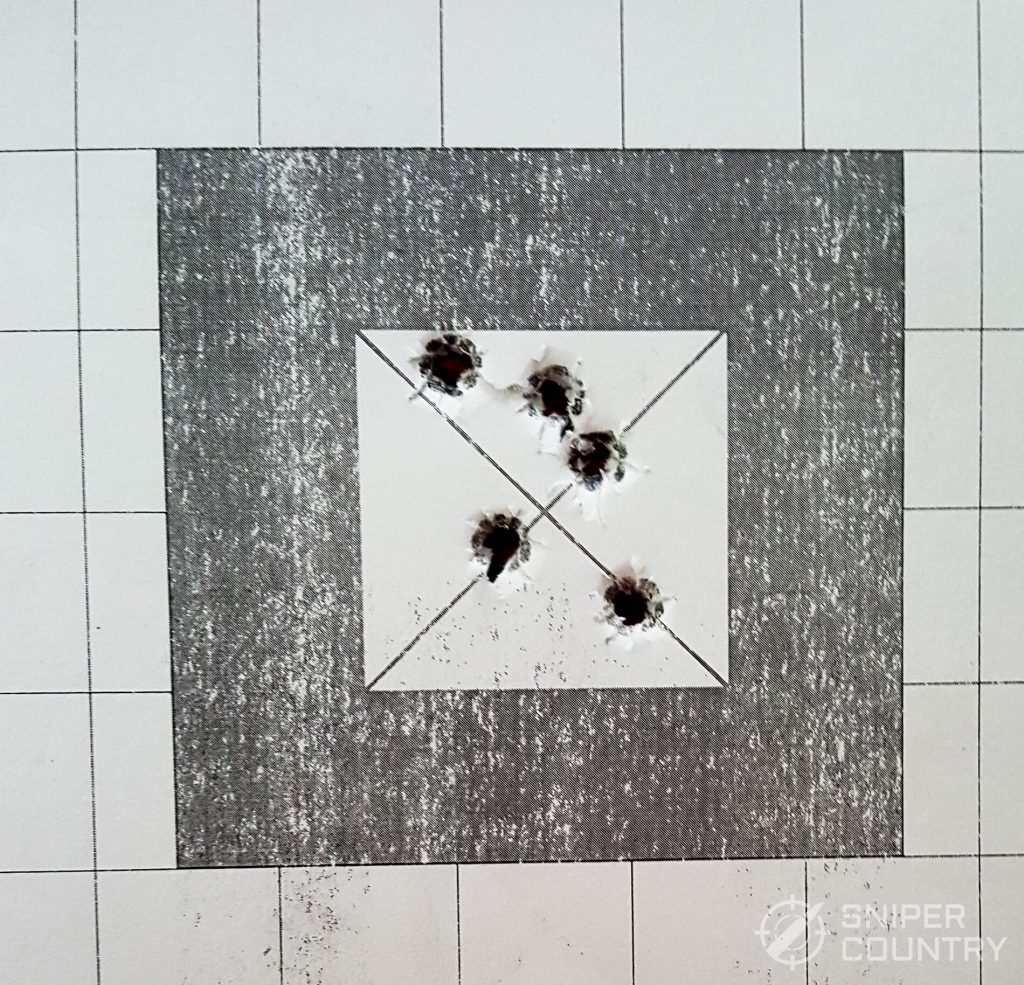
I hate to say this (not really), but my handload was the most accurate of all four loads. It is a soft-shooting load that functions the gun reliably and won’t break the bank, to be sure. The square centers of this and the top target is 2 inches, while the round-centered targets’ center measures not quite that. (I put a 1-inch grid on all these targets in order to get a quick idea of group sizes). So, this load shot into less than 2 inches, at the tested distance.
Notice also that all four loads shot to the sights. That’s important, since you can’t drift the rear sight for windage, let alone do anything about elevation with the factory sights. (If a fixed-sight gun shoots low, normally you remove a bit of metal from the top of the front sight and that forces the group to be higher on the target. If you took any metal at all off this front sight, it would be gone). At least the Spectrum’s sights are better than some pocket .380s I’ve shot. All in all, a pleasant experience that was a bit surprising in that all the loads shot to point-of-aim and my handload did better than I expected it to.
Field-Stripping
A word about field-stripping the gun for cleaning…please do it but be careful on the reassembly.
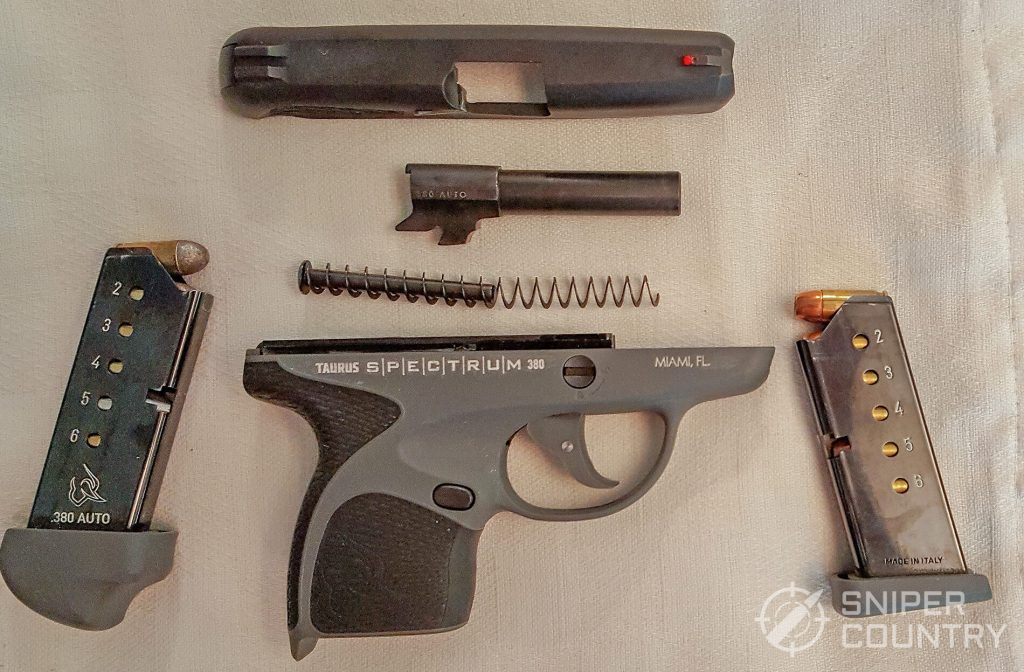
It isn’t hard at all to get the thing apart – the designers made that easy. See the slot above the trigger? Make sure the gun is unloaded, and pull the magazine out. Use a brass case rim or a screwdriver and turn the “screw†(takedown lever) 90 degrees counterclockwise (there’s an arrow on the frame to remind you which way to go to unlock it). Once the lever is rotated to position shown above, pull the slide off towards the front. No trigger pull needed. Easy to do! Take the spring and the barrel out of the slide, clean and put it back together.
Here’s the tricky part…getting the (seemingly) 14-inch-long recoil spring back in place. I put the barrel in as per normal, then proceeded to try to compress that spring on its guide rod as I seated it in the slide. It’s only about a 12-pound spring but, if you’ve ever played with a Slinky, then you get the idea. Spring bends up, spring bends down, repeat… Being not overly gifted in the mechanical ability department, I looked up a YouTube video where the guy said “try to keep the spring straight and…†He lost me at keeping the spring straight. The trick is to keep the start of the coil (point of the spring) at 12:00 so that when you DO get it back in place, the muzzle-end of the spring is seated in its place, there under the barrel port, which will allow the slide to be slid back onto the frame. If it’s not, you’ll get the slide almost all the way home…except for about a half an inch. Keep working with it and you’ll get it. Once figured out, it’s not a big deal. It just has a learning curve, that’s all. A bonus – notice the long one-piece rail for the slide to ride on – that’s a great thing to have.
The Striker Spring (Learn From My Mistakes…)
When I first got my Spectrum, I had misfires with just about every magazine-full I shot. Having owned several Tauruses (Tauri?), I knew that they packed them full of shipping grease for the trek to the U.S. from Brazil. Well…all well and good, but this little guy was made in Florida so I figured they wouldn’t need as much grease. Wrong. Every nook and cranny was full, including the firing pin/striker channel. I thought I had cleaned it out well enough, especially after verifying that the excess grease was indeed the cause of the malfunctions. I even watched a few videos on YouTube concerning the cleaning aspect. So, I hosed it down with spray gun cleaner and then blew it out with my air compressor, a trick that was suggested by several people online. That worked. The misfire situation was greatly improved.
Springing Forward?
Fast forward to a couple months ago…I wanted to make darn sure that things were staying clean inside that channel, so I thought I’d physically clean it. I had to remove the striker and spring in order to do so. I pulled the back striker plate off – all good – and then proceeded to watch the spring launch itself out of the slide without having so much as a towel for it to fly into, to catch it. I found out that a metal aerosol can of spray cleaner does not catch “sprung springs. It hit that can and rebounded, with an amazing arc, into parts unknown in our 45-foot pole barn. I had committed the Rookie Cleaning Sin (RCS)…ALWAYS assume that springs will, uh, spring when let loose. I have taken apart more guns than I can remember but I still committed that error. I at least found the pin. So, a chat with Taurus Customer Service online (WAY better than calling them – I was hooked up with someone within 3 minutes) produced the unwelcome news that the particular spring that launched itself into low Earth orbit is a restricted part, and cannot be mailed out. So, I sent the gun in at my expense. I was told it would take 12 weeks until I got the gun back (old Taurus timetable), but it was more like 7-8 (newer, trying-to-improve-things timetable). No charge, and they replaced not only that pin but other parts, too. I sincerely think Taurus is trying to upgrade its customer service…heaven knows they needed to. Anyway, it works great.
The moral of the story…do not take the back striker plate off unless you have to, and, if you do, have a towel handy to catch errant springs, or at least have a friend with good eyes handy to look for it.
I have found that shooting my Spectrum is fun. And, since I carry it a lot, shooting a lot is a necessary thing to do. Speaking of carrying it…
Carrying The Spectrum
Since it was designed as a pocket pistol, that’s how I carry it. I do use a pocket holster – a Blackhawk! #1 – and I do not carry anything else in that pocket when the gun is there.
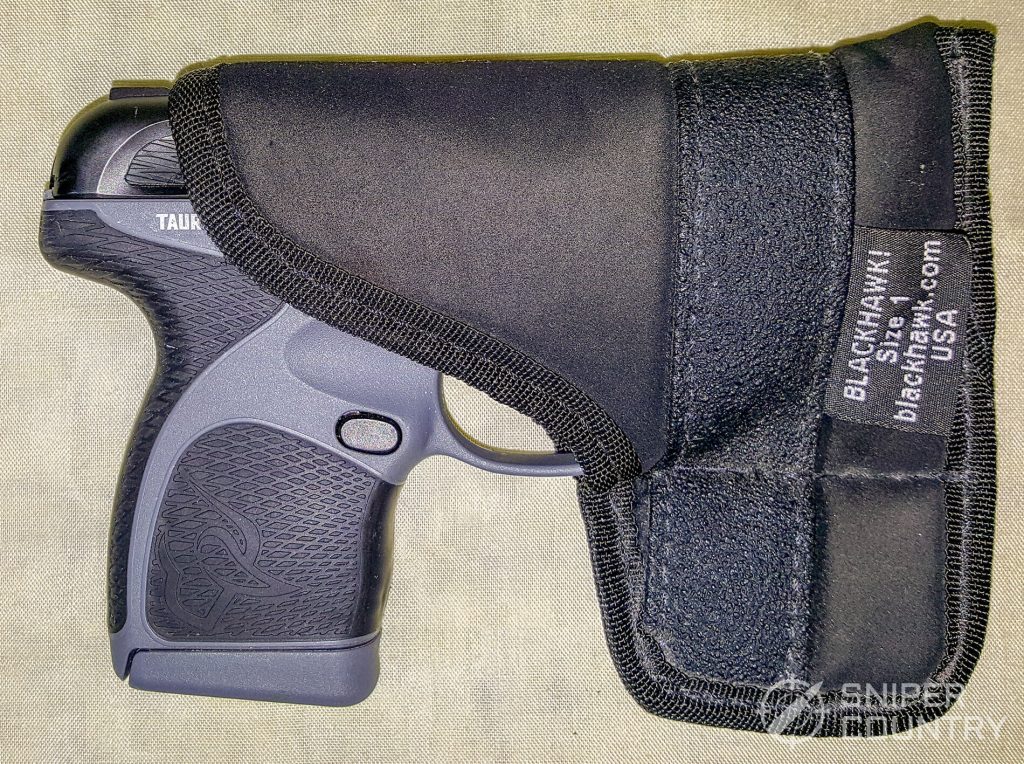
Don’t just stick the gun in your pocket – put it in a CCW holster. Here’s the main reason why you should do so:
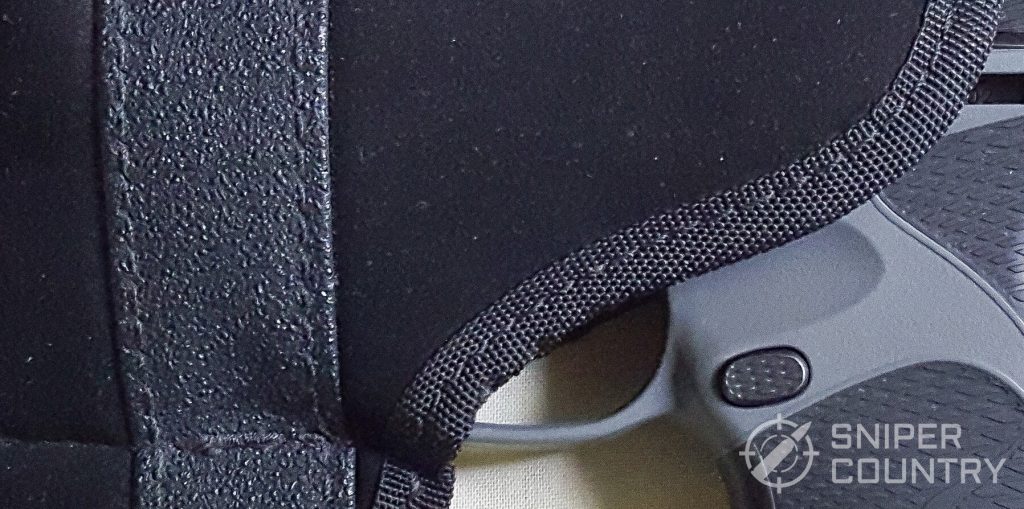
…the trigger is covered. This is a #1-size holster…a #2 might cover the whole trigger and mag release, but I have similar holsters and find that they are harder to draw from. The main purpose of a pocket holster is to protect the trigger from being accidentally pressed while the gun is being drawn or re-holstered, resulting in an accidental discharge. (Always pull the holster out of your pocket in order to re-holster the gun-don’t fish around for the opening of the holster with the gun’s muzzle). The secondary function of the holster is to keep the gun upright and accessible so it doesn’t end up slide-down at the bottom of your pocket.
There are many good pocket holsters out there – you probably have a few if you carry that way – so find one you like, that works for you and carry your Spectrum. If you are an inside-the-waistband or appendix-carry type, there are holsters for those positions as well.
It hides well, as a 10-ounce-gun should. Can you see it in my pocket? Trust me, it’s there. It conceals very well.
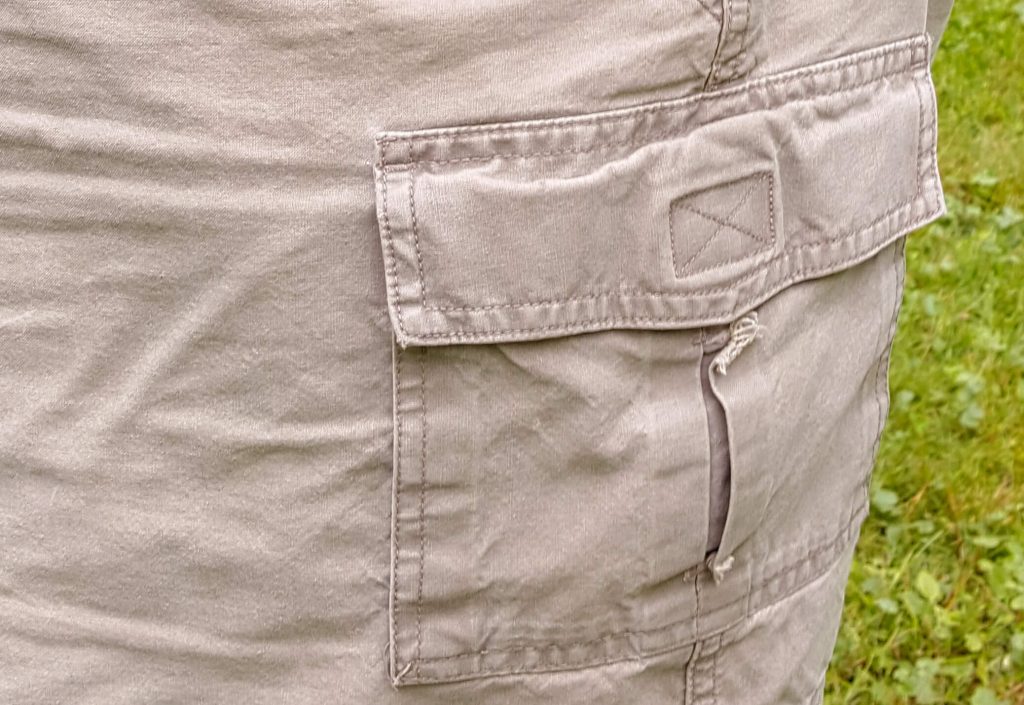
In Summary…
I like my Spectrum. I carry it a lot, to all sorts of places (I got a concealed carry insurance). I know that it will fire if it needs to – I’ve shot it a lot – and I am comforted knowing that I have something more than a rock with which to defend myself or my family if the need were to arise. Would I rather have a more substantial caliber with me? Sure, I own 9mm guns and .45 ACP pistols but they don’t disappear into my pocket like the Spectrum does. And, if a gun is easy to carry, you’ll carry it most all the time. This beats not carrying that .45 because it’s “too big†– any gun with you is better than the one you left at home. With the improvements that have been made in bullet technology and .380 ballistics, it isn’t the anemic “pipsqueak†that it was perceived to be for many years. After all, some shots from a .380 were the catalyst that started WWI.
If you are looking into acquiring a “pocket rocketâ€, give the Spectrum a look. Taurus has recently gone back to a lifetime warranty for the original purchaser, so you don’t have much to lose. And, add in the low prices that we’re seeing for these guns and that makes it a pretty good deal. (I just saw one online, new, from a major retailer for $130, as I mentioned above). What really sold me on the Spectrum and caused me to ditch the Kel Tec P3AT were the facts that the Spectrum’s slide locks open on an empty magazine, and you get two magazines. The bonus that one of those mags has a finger extension and holds an extra round is just icing on the cake.
Even if a Glock 19 is your main CCW, it never hurts to have an extra back-up gun – the Spectrum really fulfills that need. Rounded and “melted†where it needs to be, reliable, easy-to-grab soft-touch frame and slide inserts, two magazines…you could surely do worse. Let me know how you feel below as you share your experiences with the Spectrum.

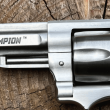



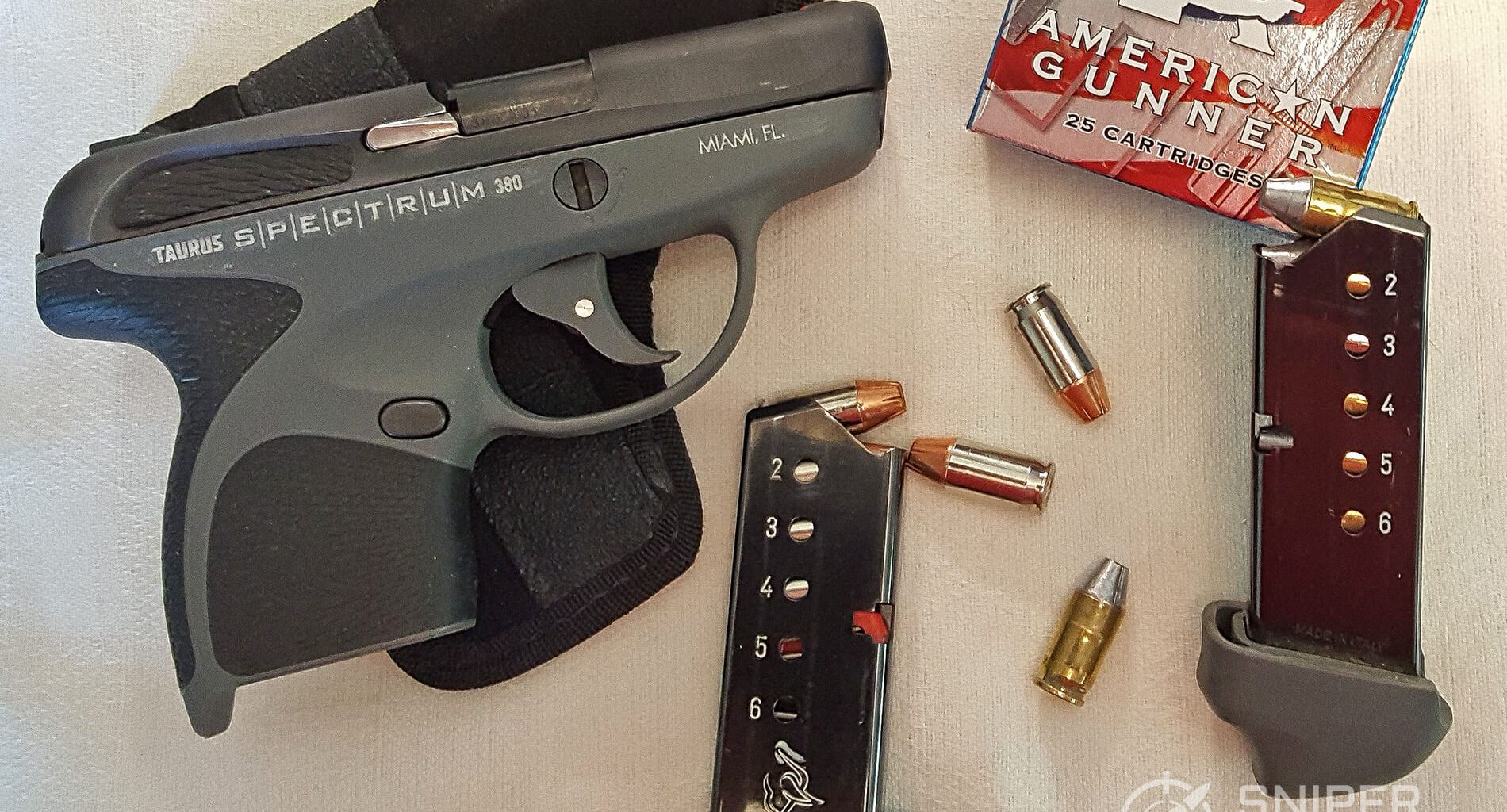
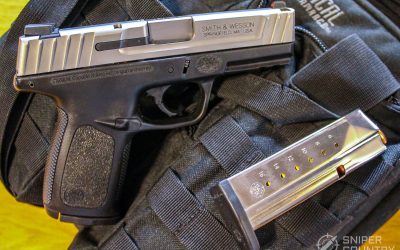

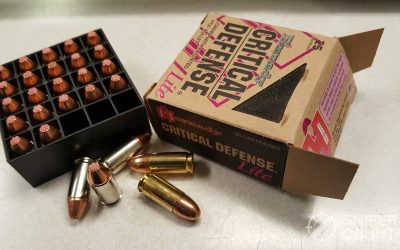
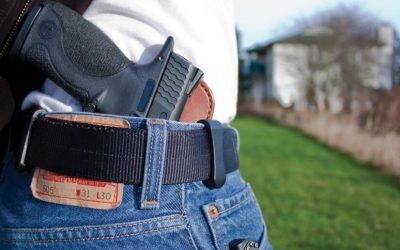
![9mm Glock Models [Ultimate Guide]](https://www.snipercountry.com/wp-content/uploads/2018/10/Glock-17-vs-Glock-19-vs-Glock-26-vs-Glock-41-vs-Glock-43-WM-400x250.jpg)
![Handgun Caliber Chart [2025 Ultimate Guide]](https://www.snipercountry.com/wp-content/uploads/2018/10/Handgun-Caliber-Comparison-400x250.jpg)
![Rifle Calibers [Ultimate Guide]](https://www.snipercountry.com/wp-content/uploads/2018/12/Header-1900-400x250.jpg)

